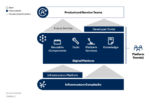Most teams are somewhere on the path to DevOps maturity, with just 11% saying they’ve implemented full automation in DevOps. This means that despite being around for almost two decades, most organizations are still figuring out what full DevOps adoption looks like for their teams. However, after years of disruption, rising customer expectations for digital experiences, and economic turmoil, C-suite patience for gradual transitions is limiting, pushing software teams to overcome long-term DevOps hurdles and prove ROI.
Quality engineering is the practice of including quality testing throughout the development lifecycle, with the purpose of delivering a positive user experience that will help you satisfy, retain, and acquire new customers. It is emerging as a complement to DevOps that helps teams overcome common challenges to transformation. By focusing their efforts on quality engineering, development leaders can help their organizations finally achieve DevOps success.
Software Testing Transformation Supports Customer Happiness During DevOps Transition
Let’s face it: change, even positive change, is hard. Many software companies find themselves trapped between the need to modernize their development pipelines and the concern that the transition will cause too much disruption for their customers. The latter often wins out as most businesses now compete on their customer experience: 75% of American consumers say it plays a major role in their purchasing decisions, and 32% say they’ll leave a brand after just one bad interaction. This highly competitive environment creates an understandable aversion to change that slows many DevOps adoptions.

Building the DevOps journey around technologies and processes that support better customer experiences helps software development teams overcome the inevitable headaches that occur during transitional phases and ensures customers don’t suffer the consequences. According to mabl’s 2021 Testing in DevOps Report, 80% of teams with high test coverage reported high customer satisfaction. This number is impressive on its own, but even more striking when compared to organizations with low test coverage: just 30% of low test coverage teams reported high customer happiness.
Rather than abandon DevOps adoption in the pilot stage, automating software testing is a low risk, high reward place to embrace automated, collaborative DevOps pipelines without risking the user experience.
Streamlining Collaboration in DevOps Pipelines
DevOps seeks to support faster, more dynamic development teams by building a shared workflow that emphasizes collaboration. When product owners, developers, and quality professionals can easily work together, they’re able to easily hand off issues so that defects are addressed quickly. It’s no surprise, then, that the further teams were in the DevOps adoption process, the better they felt about collaboration between teams.
Starting the DevOps journey by evaluating points of collaboration like the handoff between quality teams and engineering addresses a major challenge to DevOps adoption: slow processes and a reluctance to change. Streamlining these essential functions not only helps individual team members see the value in DevOps adoption, it also reduces the likelihood that customers will have a bad experience as the result of a software defect that escaped into production. With defects easier to manage, DevOps teams can focus on improving the product, adding new features, and making the overall customer experience better.
Closing the DevOps Loop
With just 11% of organizations saying that they’ve reached fully automated pipelines, it’s clear that momentum is still building for DevOps adoption. But while DevOps is still a priority for many software development teams, there are still serious obstacles on the road to success. And as the world enters a new period of highly competitive market conditions, the teams that can successfully modernize their pipelines for iterative, quality-centric development will be best positioned to succeed. The time for DevOps experimentation is over – it’s time for DevOps success.
Improving software testing with test automation and better cross-functional collaboration processes is an underestimated – and undervalued – avenue to DevOps maturity that can help software organizations finally realize their goals. By emphasizing quality engineering metrics like test coverage and how well quality and engineering teams can collaborate, DevOps leaders will be better prepared to showcase business value and tackle the cultural shifts that continue to inhibit DevOps maturity.
Content provided by mabl.






